CLICK HERE for the latest market quotes from the Iowa Agribusiness Network!
CLICK HERE for the latest market quotes from the Brownfield Ag News Network!
CLICK HERE for the latest market quotes from the Iowa Agribusiness Network!
CLICK HERE for the latest market quotes from the Brownfield Ag News Network!
(Radio Iowa) – The Emerald ash borer is now confirmed in all 99 Iowa counties and the impact can be seen across the state. Entomologist Mike Kintner oversees the state Ag Department’s efforts to battle the invasive beetle and says ash trees make up half the trees in some communities. “After emerald ash borer moves through a community, you can really see the impact it has, not only aesthetically, but also financially. It can kind of put a burden on municipalities with resources and also homeowners,” he says. Kintner says preventive insecticide treatment is an option for healthy ash trees. But once they show severe symptoms – like dead branches in the top third of the tree – recovery is less likely.
Kintner says the damage is easiest to spot in summer when healthy branches leaf out. “Even during the winter months you can still find E-A-B in trees even though the leaves are off, because what happens is the woodpeckers will come in if a tree’s infested,” Kintner says.
The woodpeckers dig into the tree bark to eat the larvae underneath. Infested ash trees tend to die within two to four years. As landowners and communities consider replacing these trees, Kintner [ recommends planting with diversity in mind.
(Midwest News) – The National Corn Growers Association and the American Soybean Association found a tariff-induced trade war with China would “hurt” U.S. farmers, based on a jointly released study that pulled from 2018 tariffs data and GOP presidential nominee Donald Trump’s economic plans. The study, reported by the Iowa Capital Dispatch, shows worse-case scenario figures in the study show that soybean exports to China would have an average decline of nearly 52% below baseline expected levels, and corn exports would have an average decline of 84% below baseline.
Agricultural representatives, including folks from Farmers Unions in Minnesota and Wisconsin, the Minnesota Soybean Growers Association and Iowa former Secretary of Agriculture and former Lt. Gov. Patty Judge among others met Wednesday for a webinar in response to the study. Many in the webinar urged farmers and rural voters not to vote for former President Trump because of his proposed tariffs. “We know that elections have consequences, and unfortunately, this one could leave us in a very precarious position (for) those of us here in the heartland that try to make a living on the great soil,” Judge, a Democrat, said.
The study, released Oct. 15, was conducted by the World Agricultural Economic and Environmental Services and projected a new trade war would cause “immediate” drops in corn and soybean exports, which would quickly be filled by exports from Argentina and Brazil. According to the trade study, many of the tariffs from the 2018 U.S.-China trade war are still in place, but China has granted annual waivers to the U.S. to reduce the tariff costs. This has worked to quell the trade war in recent years, but the study says the existing tariffs from China could “easily be reinstated.”
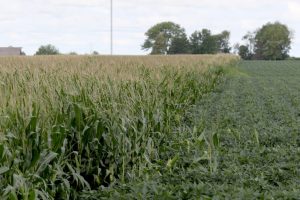
(Photo by Jared Strong/Iowa Capital Dispatch)
The study pulls from two scenarios, one where China fully reinstates the 2018 tariffs, and another where China applies a 60% tariff on U.S. goods, based on Trump’s proposal to place a 60% tariff on Chinese goods. According to the study, that could lead to an average loss for U.S. soybean farmers of $3.6 billion to $5.9 billion and $0.9 billion to $1.4 billion for corn farmers in annual production value. The agricultural representatives on the Wednesday webinar spoke frequently of the 2018 trade war and the “devastating effects” it had on farmers and rural economies. The effect was acknowledged by the former administration, which issued $23 million in relief to farmers who suffered a loss of trade because of the high tariffs.
Patty Judge said the tariffs could be “catastrophic” to Iowa because of its large agricultural production compared to its relatively small land mass and population. “We saw what happened in 2018 and we simply cannot do it again,” Judge said. According to the Office of the U.S. Trade Representative, Iowa is the second largest agricultural export state, and shipped $16.5 billion of domestic agricultural exports in 2022. Brent Swart, the president of Iowa Soybean association, noted the importance of trade to Iowa soybean farmers in an emailed statement to Iowa Capital Dispatch. “Many farmers could share a similar story of depressed commodity prices and sustained financial squeeze following the start of the U.S.-China trade dispute,” Swart said. “Trade remains a top priority for U.S. soybean farmers, and this study only underscores its importance.”
(Des Moines, Iowa; DNR News) – The Iowa Department of Natural Resources reports success during the 2023 pheasant season has Iowa hunters eagerly awaiting this year’s opening day and with bird population estimates similar to two years ago, hunters are expecting another great fall afield. The DNR’s annual August roadside survey found the statewide pheasant population to be 19 birds per 30-mile route, down from 23 birds per route last year. The decline was likely due to a wetter than normal spring that coincided with the nesting season. Based on the results, hunters can expect a harvest between 350,000 and 400,000 roosters.
This year’s hunting excitement comes on the heels of a successful 2023 season that had a jump in harvest to 590,000 roosters, the most since 2007, thanks to roughly 20,000 additional pheasant hunters returning to the field. An estimated 83,600 pheasant hunters participated in 2023, and many of those came from out of state. Iowa has been attracting pheasant hunters from Minnesota, Michigan, Wisconsin, Illinois, Missouri, Ohio, Nebraska and from as far away as Georgia, North Carolina and Alabama. Hunters can expect to find higher populations in west central and northwest regions, followed by central and north central Iowa.
Pheasant hunting has been an Iowa tradition spanning generations. This year, it starts with the resident youth-only pheasant season Oct. 19-20 that is only open to Iowa youths aged 15 and younger. Iowa’s regular pheasant season is Oct. 26-Jan. 10, 2025. For decades, Iowa was a pheasant hunting destination and the 2024 season marks the end of the first century of pheasant hunting in the Hawkeye State.
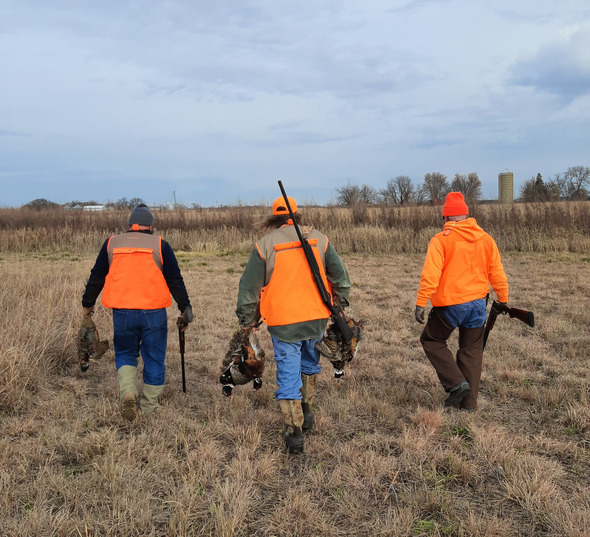
Pheasant hunting (IA DNR photo)
The Iowa DNR and Pheasants Forever are partnering to celebrate Iowa’s 100-year tradition of pheasant hunting beginning this fall, and running through October 2025. History, news stories, population surveys, places to hunt, classes and events, links to other resources and more is all available on a new webpage at https://info.gooutdoorsiowa.com/100-year-pheasant-anniversary/ marking the 100-year anniversary. The page will be updated throughout the year.
Iowa hunters have been using the interactive Iowa hunting atlas to find new places to go hunting. The hunting atlas features more than 680,000 acres of public hunting land that is owned by the state, county or federal governments. It’s available online at www.iowadnr.gov/hunting. The tool allows hunters to see which zone the public area is in, type of shot allowed, wildlife likely to be found and get an overhead look at the terrain. The mobile version of the atlas will show hunter location on the area if granted permission. The atlas view from above allows hunters to zoom in on an area, see how to get there, the lay of the land and where one parcel of public hunting land is in relation to others and print off maps. Information is updated as public hunting lands are acquired.
The hunting atlas also includes 33,000 acres of private land enrolled in the Iowa Habitat and Access Program (IHAP) where private landowners receive assistance to improve habitat on their land in exchange for opening the property for hunter access. Site maps are available at www.iowadnr.gov/ihap showing boundaries and which species would be most likely attracted to the habitat. Walk-in public hunting through IHAP is available between September 1 and May 31.
(Western Iowa) – Firefighters across western and southwest Iowa battled large field/grass fires Thursday afternoon. According to a social media post by Portsmouth Fire Chief Mike Leinen, crews fought a blaze that was three-miles long and about one-half mile wide. The cause of the fire is not known. Portsmouth firefighters received assistance from multiple area fire departments inside and adjacent to Shelby County. Their efforts were aided by at least two-dozen farmers who used their disc implements to cover over 400-acres in less than 30-minutes, in order to prevent the fire from spreading even more.
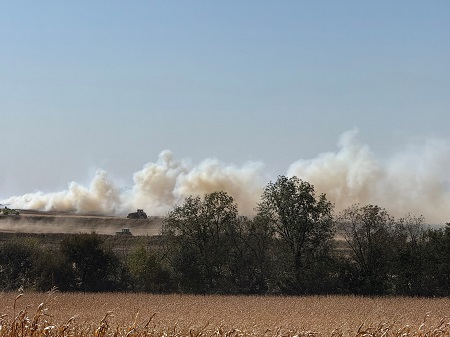
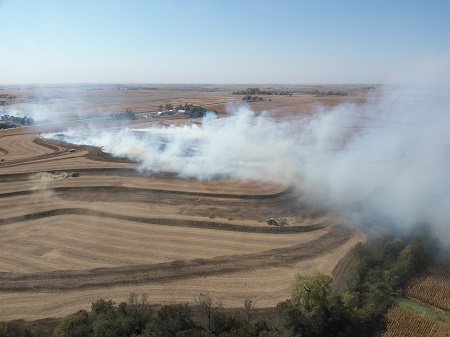
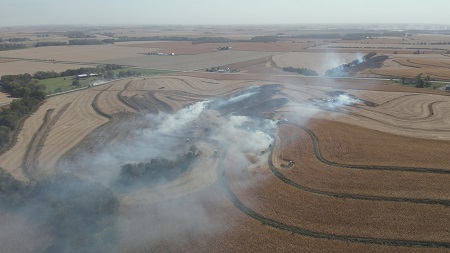
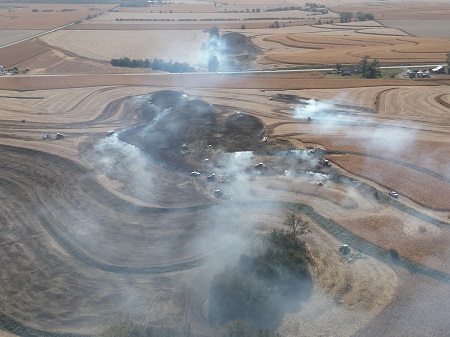
(Radio Iowa) – The final Iowa county has fallen to the Emerald ash borer invasion. The invasive insect that destroys ash trees was discovered recently in an ash tree in Armstrong in Emett County in northwest Iowa, marking the 99th county with an infestation. The first E-A-B infestation was discovered in Allamakee County in eastern Iowa in 2010.
There were an estimated 54 million woodland ash trees and three million in urban areas when the outbreak was first discovered. Many infect ash trees were cut down, and some were also cut down as a precaution. Some tree owners have opted to treat their ash trees to keep them alive as long as they can.
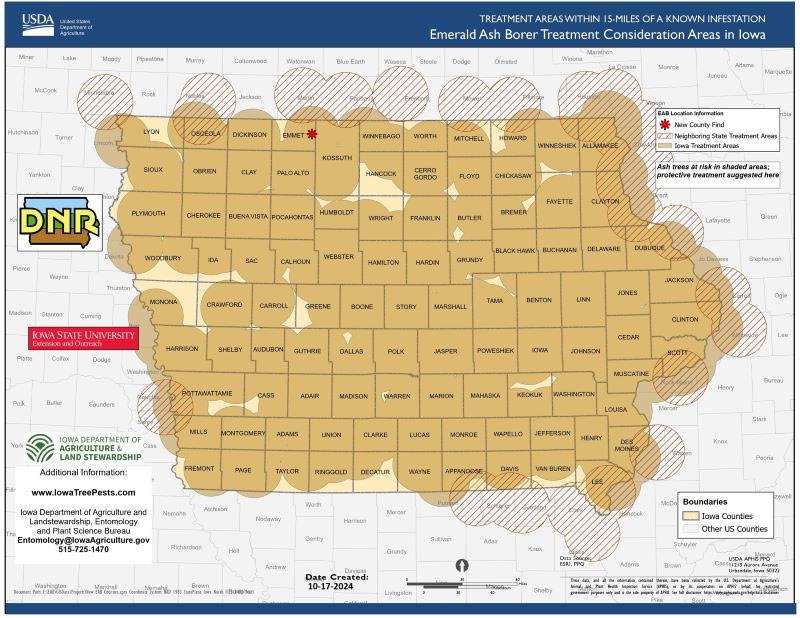
EAB is now found in all 99 counties after being discovered in Emmet county.
(Radio Iowa) – The Emmet County Board of Supervisors has approved a temporary moratorium on construction permits for new wind energy projects in the county. The county’s planning and zoning board has proposed updates to zoning rules for wind turbines. Supervisor Tim Schumacher of Estherville says the board now has time to review the proposal.
“We just need to tap the brakes a little bit, take a breath and try to catch up with technology on our ordinance,” Schumacher said. “The technology’s gone far greater than any of us imagined in the last 10-12 years since we developed the original ordinance and we just need to catch up so we can have the same assurances in place that we had with the original.”
The moratorium will be in effect until January 31st of next year. Schumacher, who says he has been and remains a supporter of wind energy, say county officials now have time to review the potential impact of wind turbines on Emmet County residents. 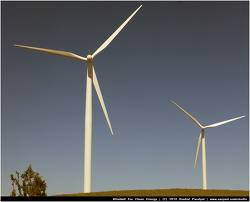
“We are probably one of the highest in the state as far as wind speed – probably 17.5 (miles per hour) or better,” Schumacher says, “and so as I look at ways to keep Emmet County strong and develop Emmet County, that seemed like a logical choice.”
A public hearing on the new wind energy ordinance will be held next Thursday, October 24th, at the Emmet County Courthouse. Earlier this year developers of the Red Rock Wind Energy project said they plan to erect 18 turbines in Emmet County. The company submitted its application for a construction permit to Emmet County officials earlier this month.
(Radio Iowa) – The U-S-D-A crop report shows one-quarter of the bean crop was harvested in the week that ended Sunday. That puts the soybean harvest at 81 percent complete — six days ahead of last year and ten days ahead of the average. The report says south-central Iowa farmers are behind the rest of the state, with only 54 percent of their soybeans done. The corn harvest more than doubled so 45 percent of corn is now out of the fields. That’s three days ahead of last year and six days ahead of the five-year average.
(Iowa DNR News) – Despite warm weather persisting in much of the state, roughly 6,000 deer have been registered so far through the youth and disabled hunter seasons, and the opening of the archery and early muzzleloader seasons, which is slightly higher than both last year and the five-year average. The crop harvest, cooling temperatures and approaching rut, should increase deer activity leading to greater harvest success. The long-anticipated rut, which will be in full swing by November, is when mature bucks spend much of their time actively tending and searching for does during daylight hours, creating opportunity for thrilling action from the tree stand at any hour of the day.
A major factor leading to Iowa’s world-renowned buck quality is the simple fact that hunting during the rut – when bucks are most vulnerable – is restricted to compound and traditional bows. The archery season runs through Dec. 6, then closes for the two regular gun seasons before re-opening Dec. 23 through Jan. 10, 2025. The early muzzleloader season closes Oct. 20.
Deer Disease Update:
Iowa’s deer population is in the midst of another outbreak of hemorrhagic disease, which tends to affect Iowa deer from late summer to early fall. Though outbreak severity varies annually, it began increasing in September, with roughly 750 related deer mortalities reported throughout the state, which is considered a moderate outbreak compared to past years. The DNR added new online tools to the Deer Hunting webpage that allow the public to report and monitor hemorrhagic disease activity. Hemorrhagic disease has been reported in at least 78 Iowa counties, though disease activity has generally been mild at the county scale at fewer than 50 mortalities per county.
Chronic Wasting Disease (CWD) continues to increase in geographic spread and prevalence, though most Iowa counties have yet to detect their first CWD-positive deer. Last year, eight new counties were added to the list: Des Moines, Guthrie, Howard, Jones, Marshall, Monroe, Muscatine, and Tama, bringing the total number of counties that have had a positive deer to 23.
Testing of hunter-harvested deer is available in each county by contacting the local DNR wildlife or law enforcement staff. Hunters can help limit the spread of chronic wasting disease by refraining from feeding/baiting deer and transporting deer carcasses across counties. The Iowa DNR primarily manages the disease in areas with moderate-to-high deer densities by adding antlerless tags within special Deer Management Zones.
SHENANDOAH – The Iowa Department of Natural Resources (DNR) is partnering with Optimal Aquafeed and Page County Conservation Board to stock rainbow trout at 9 a.m., Oct. 19, in RAPP Park outside of Shenandoah. Approximately 800 rainbow trout ranging from around 1- to 2-pounds, from Optimal Aquafeed will be stocked by the Iowa DNR in a small borrow pit on the RAPP Park property.
Anglers 16 years and older must have a valid fishing license and pay the trout fee to fish for or possess trout. The daily limit is five trout per licensed angler with a possession limit of 10. Children age 15 or younger can fish for trout with a properly licensed adult, but they must limit their catch to one daily limit. The child can pay the trout fee which will allow them to catch their own limit of five trout.
This is the fourth year of this successful partnership that provides a unique fishing opportunity to anglers in southwest Iowa.